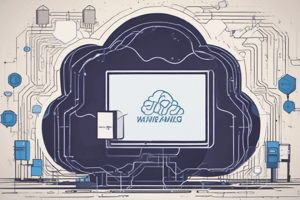Podcast
Questions and Answers
Which statement about subnets in a VPC is true?
Which statement about subnets in a VPC is true?
- You cannot create more than one subnet in a single Availability Zone.
- All subnets in a VPC must be public.
- A subnet can span multiple Availability Zones.
- A subnet is tied to a specific Availability Zone (AZ) in a VPC. (correct)
What is the main function of a NAT Gateway in a VPC?
What is the main function of a NAT Gateway in a VPC?
- A NAT Gateway enables resources in private subnets to access the internet while preventing inbound traffic from the internet. (correct)
- A NAT Gateway allows inbound internet traffic to private subnets.
- A NAT Gateway is used to connect private subnets to other VPCs.
- A NAT Gateway is required for all internet access in a VPC.
Which characteristic differentiates Security Groups from Network ACLs?
Which characteristic differentiates Security Groups from Network ACLs?
- Security Groups apply to entire subnets, while NACLs apply to individual instances.
- Security Groups use rules that allow or deny traffic, while NACLs only allow traffic.
- Security Groups are stateful, while Network ACLs are stateless. (correct)
- Security Groups have higher priority than Network ACLs.
Which routing policy in Amazon Route 53 is designed to enhance performance by directing users to the closest Regional endpoint?
Which routing policy in Amazon Route 53 is designed to enhance performance by directing users to the closest Regional endpoint?
What is a key difference between a Virtual Private Gateway and an Internet Gateway in a VPC context?
What is a key difference between a Virtual Private Gateway and an Internet Gateway in a VPC context?
What type of IP addresses are Elastic IPs primarily used for in a VPC?
What type of IP addresses are Elastic IPs primarily used for in a VPC?
Which of the following is NOT a capability of Amazon Route 53?
Which of the following is NOT a capability of Amazon Route 53?
Which statement about the routing tables in a VPC is accurate?
Which statement about the routing tables in a VPC is accurate?
What is a potential risk when using public subnets in a VPC?
What is a potential risk when using public subnets in a VPC?
In what way do Network ACLs provide a layer of security compared to Security Groups?
In what way do Network ACLs provide a layer of security compared to Security Groups?
What is the primary function of Amazon CloudFront?
What is the primary function of Amazon CloudFront?
Which of the following is a key feature of AWS Direct Connect?
Which of the following is a key feature of AWS Direct Connect?
In which scenario would AWS Global Accelerator be the most beneficial?
In which scenario would AWS Global Accelerator be the most beneficial?
What type of traffic control do Network ACLs provide?
What type of traffic control do Network ACLs provide?
What use case is AWS VPN predominantly suited for?
What use case is AWS VPN predominantly suited for?
Which service is best suited for routing global traffic for real-time applications?
Which service is best suited for routing global traffic for real-time applications?
Which combination of services would best support a business needing to regularly transfer large amounts of data with low latency?
Which combination of services would best support a business needing to regularly transfer large amounts of data with low latency?
Which of the following best describes how AWS Global Accelerator functions?
Which of the following best describes how AWS Global Accelerator functions?
What is the main advantage of utilizing Amazon CloudFront for delivering content?
What is the main advantage of utilizing Amazon CloudFront for delivering content?
Which of the following best represents a key takeaway about AWS's VPC service?
Which of the following best represents a key takeaway about AWS's VPC service?
Flashcards
Public Subnet Components of a Virtual Private Cloud (VPC)
Public Subnet Components of a Virtual Private Cloud (VPC)
Accessible from the internet, typically for web servers.
Virtual Private Cloud (VPC) Subnets
Virtual Private Cloud (VPC) Subnets
Divide a Virtual Private Cloud (VPC) into smaller, isolated segments.
Internet Gateway
Internet Gateway
Connects resources in a public subnet to the internet.
Private Subnet Components of a Virtual Private Cloud (VPC)
Private Subnet Components of a Virtual Private Cloud (VPC)
Signup and view all the flashcards
Route Tables
Route Tables
Signup and view all the flashcards
NAT Gateway
NAT Gateway
Signup and view all the flashcards
Virtual Private Gateway
Virtual Private Gateway
Signup and view all the flashcards
Security Group
Security Group
Signup and view all the flashcards
Elastic IPs
Elastic IPs
Signup and view all the flashcards
Network ACL
Network ACL
Signup and view all the flashcards
What does Security Groups (Stateful) mean?
What does Security Groups (Stateful) mean?
Signup and view all the flashcards
What are the key features of Amazon Route 53?
What are the key features of Amazon Route 53?
Signup and view all the flashcards
Amazon Route 53
Amazon Route 53
Signup and view all the flashcards
What does Network ACLs (Stateless) mean?
What does Network ACLs (Stateless) mean?
Signup and view all the flashcards
Virtual Private Cloud (VPC)
Virtual Private Cloud (VPC)
Signup and view all the flashcards
AWS VPN (Virtual Private Network)
AWS VPN (Virtual Private Network)
Signup and view all the flashcards
Edge Services - AWS Global Accelerator
Edge Services - AWS Global Accelerator
Signup and view all the flashcards
AWS Direct Connect
AWS Direct Connect
Signup and view all the flashcards
Edge Services - Amazon CloudFront
Edge Services - Amazon CloudFront
Signup and view all the flashcards
Study Notes
Virtual Private Cloud (VPC) Components
- A VPC is a logically isolated network within AWS to securely run resources.
- Provides full control over the networking environment.
- Subnets: Divide the VPC.
- Public Subnets: Accessible from the internet, often for web servers.
- Private Subnets: Not internet-accessible, for databases and backend systems.
- Gateways:
- Internet Gateway: Allows public subnet resources to access the internet.
- NAT Gateway: Enables private subnet instances to connect outbound, but blocks inbound internet traffic.
- Virtual Private Gateway: Connects on-premises data centers securely via AWS VPN.
- Route Tables: Define how traffic moves within the VPC and to external destinations (internet, other VPCs).
- Elastic IPs: Static IP addresses for EC2 instances in public subnets.
Security in a VPC
- Security Groups: Firewalls at the instance level, controlling inbound/outbound traffic.
- Example: Allow SSH (port 22) only from specific IPs.
- Network ACLs (Access Control Lists): Subnet-level firewalls, controlling traffic for all subnet resources.
- Example: Deny all traffic from a specific IP address.
- Key Differences (Security Groups vs. NACLs):
- Scope: Security Groups operate at the instance level, NACLs at the subnet level.
- Statefulness: Security Groups are stateful (track connections), NACLs are stateless.
- Rules: NACLs have "allow" and "deny" rules, Security Groups mostly use "allow" but can have a complex combination of rules depending upon the need .
Amazon Route 53
- A DNS (Domain Name System) service that routes traffic.
- Domain Registration: Register and manage domain names.
- DNS Routing: Translates domain names (e.g., www.example.com) into IP addresses.
- Routing Policies:
- Simple Routing: Maps a domain name to a single resource.
- Latency-Based Routing: Routes to the closest Region for lower latency.
- Failover Routing: Automatically redirects traffic for failed resources.
- Use Case: Route 53 directs users to the nearest, fastest, or healthiest endpoint.
Edge Services
- Amazon CloudFront: A CDN (content delivery network) caching content at global edge locations.
- Purpose: Reduce latency by serving content closer to users.
- Use Cases: Streaming, delivering static content.
- AWS Global Accelerator: Improves application performance by routing through AWS's global network.
- Purpose: Provides lower latency and better failover.
- Use Cases: Real-time apps, gaming.
Network Connectivity Options
- AWS VPN (Virtual Private Network):
- Secure connection between on-premises networks and AWS.
- Uses IPsec tunnels. Suitable for lower bandwidth needs.
- Use Cases: Connecting from office/data center.
- AWS Direct Connect:
- Dedicated private connection between on-premises and AWS.
- Bypasses the public internet. Supports up to 100 Gbps.
- Use Cases: Large-scale data transfers, low-latency needs.
Key Comparisons (CloudFront vs. Global Accelerator)
- CloudFront: Global content caching, suitable for static content (e.g., images, videos).
- Global Accelerator: Global traffic optimization, best for real-time or low-latency applications (e.g., gaming).
Real-World Scenarios
- Securing a VPC: Use Security Groups (instance-level) and Network ACLs (subnet-level) to prevent unauthorized access.
- Connecting On-Premises to AWS: Use AWS Direct Connect for high-speed, consistent connections if bandwidth is high.
- Improving Global App Performance: Use AWS Global Accelerator to route users to the physically nearest AWS Region.
Key Takeaways
- VPC: Securely runs resources (e.g., EC2, RDS) in a isolated virtual network.
- Security Groups: Control inbound/outbound traffic at the instance level.
- Network ACLs: Subnet-level traffic control (allow/deny).
- Route 53: Domain name and traffic routing service.
- CloudFront: Securely serves content at edge locations, for low latency content delivery.
- Global Accelerator: Global traffic optimization, ideal for low latency applications.
- AWS VPN: Securely connect lower-bandwidth on-premises networks to AWS.
- Direct Connect: High-bandwidth, consistent private connections for significant data transfer.
Studying That Suits You
Use AI to generate personalized quizzes and flashcards to suit your learning preferences.




